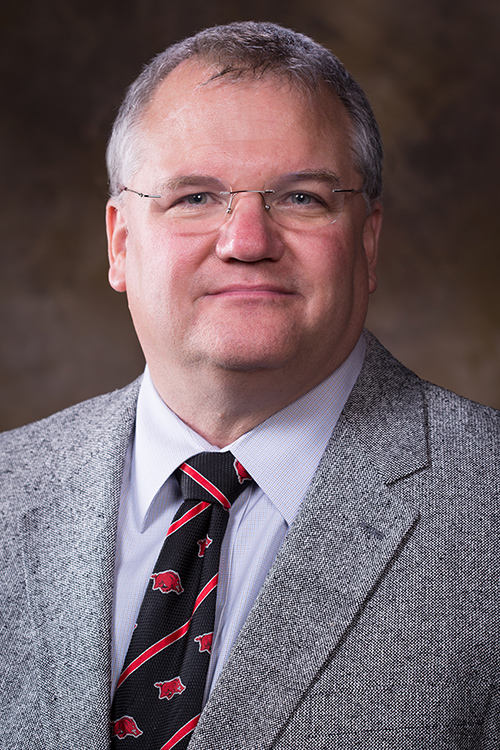U of A Athletic Training Program Used as Case Study in Excellence
FAYETTEVILLE, Ark. -- University of Arkansas professor Jeff Bonacci recently presented a case study by webinar to help athletic training education programs across the country seeking to make the transition to the graduate level.
The webinar can be heard on the National Athletic Trainers Association website. Bonacci begins speaking at about 24 minutes.
"Jeff Bonacci was invited to participate in this because his program has a long-term history of excellence in graduate professional education so we wanted to see what we could learn from him," said Russ Richardson, chairman of the national association's Executive Committee for Education.
Bonacci is a clinical assistant professor of kinesiology in the College of Education and Health Professions. The entry level master's program at the U of A was initially granted national accreditation in 2005 and it received a 10-year re-accreditation in 2010. For the past six years in a row, the program has a 100 percent pass rate for the Board of Certification exam. It has a 95 percent pass rate overall since its inception.
U of A graduates of the Master of Athletic Training degree are employed by athletic teams at all levels including professional sports, with medical practices and at colleges and universities. Several have gone on to earn doctorates.
The Commission on Accreditation of Athletic Training Education recently announced a new requirement that athletic training education be offered as a graduate-level degree. Richardson invited Bonacci to present the webinar Dec. 11 as part of the association's work to assist higher education institutions creating graduate degree programs in athletic training. In his invitation, Richardson, who is on the faculty at the University of Montana Western, cited the strength of the Arkansas program and its rich history. The purpose was to show best practices to these programs, he said.
In the webinar, Bonacci used a SWOT (strengths, weaknesses, opportunities and threats) analysis as a case study that describes how the Arkansas program was developed.
"I explained the processes and procedures we went through along the way and emphasized the importance of the support of internal and external stakeholders in developing an entry level master's program," he said. "My purpose was to help program officials break down their resources and challenges and to evaluate the potential to create a successful degree program."
Factors including institutional infrastructure, variety and number of clinical assignment opportunities, faculty expertise and the established number of clinical preceptors must be taken into account, Bonacci explained.
He began by showing a timeline of the development of the U of A program, which began with a discussion among university officials in 1998. Bonacci was hired in 2000 to develop the program, which admitted its first cohort of five students in 2002. The program accepts between 10 and 15 students each year and has about 155 graduates to date.
Bonacci advised program directors to start by looking at the makeup of their institutions, particularly the landscape of graduate education. When he accepted the position at the U of A, which is a Research 1-category institution as designated by the Carnegie Institute, he saw that the College of Education and Health Professions already offered graduate programs in health and medical education with nursing and speech pathology and that the Health, Human Performance and Recreation Department offered four doctoral programs and six master's degree programs.
"There was already a very strong mindset for graduate education," he said.
Other highlights from his presentation included advice to build strong relationships with clinical preceptors before accepting students, consider the financial resources needed for medical education, understand the financial aid available, including fellowships and reclassification for in-state tuition, helping preceptors maximize teachable moments while they are working with graduate students, base a marketing plan on personal contact with prospective students, and recognize weaknesses such as lack of clerical support and need for greater diversity of faculty expertise.
"Ask yourself what can separate you from other programs," Bonacci said. "It doesn't have to be something academic. It can be in the nature of your institution, something that is different. Here, at the University of Arkansas, what's very unique, every student who graduates gets their name etched in stone on Senior Walk."
Topics
Contacts
Heidi Wells, director of communications
College of Education and Health Professions
479-575-3138,
heidisw@uark.edu
Headlines
PetSmart CEO J.K. Symancyk to Speak at Walton College Commencement
J.K. Symancyk is an alumnus of the Sam M. Walton College of Business and serves on the Dean’s Executive Advisory Board.
Faulkner Center, Arkansas PBS Partner to Screen Documentary 'Gospel'
The Faulkner Performing Arts Center will host a screening of Gospel, a documentary exploring the origin of Black spirituality through sermon and song, in partnership with Arkansas PBS at 7:30 p.m. Thursday, May 2.
UAPD Officers Mills and Edwards Honored With New Roles
Veterans of the U of A Police Department, Matt Mills has been promoted to assistant chief, and Crandall Edwards has been promoted to administrative captain.
Community Design Center's Greenway Urbanism Project Wins LIV Hospitality Design Award
"Greenway Urbanism" is one of six urban strategies proposed under the Framework Plan for Cherokee Village, a project that received funding through an Our Town grant from the National Endowment for the Arts.
Spring Bike Drive Refurbishes Old Bikes for New Students
All donated bikes will be given to Pedal It Forward, a local nonprofit that will refurbish your bike and return it to the U of A campus to be gifted to a student in need. Hundreds of students have already benefited.





